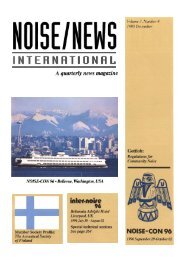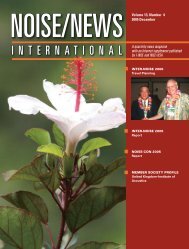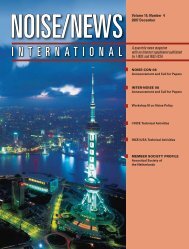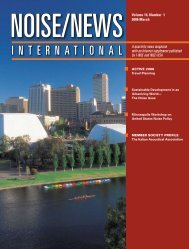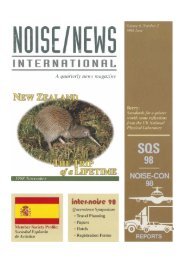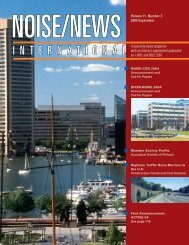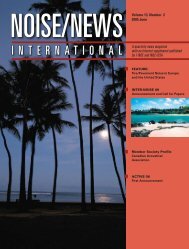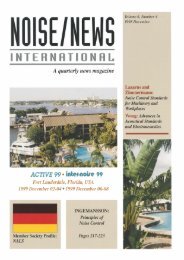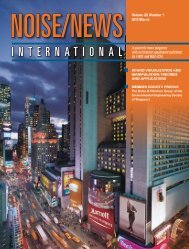Volume 4, Number 1, March, 1996 - Noise News International
Volume 4, Number 1, March, 1996 - Noise News International
Volume 4, Number 1, March, 1996 - Noise News International
- No tags were found...
Create successful ePaper yourself
Turn your PDF publications into a flip-book with our unique Google optimized e-Paper software.
sound intensity. Applicability of active noise control systemsas countermeasure against road noise. Application and casehistories of active silencers in HVAC systems.• Applicationoffast adaptive IIR filter algorithms for active noise controlin a kitchen hood. Application of sound intensity andstructural intensity to study acoustical transmission throughwindows • Attenuation of blade-passing excitation in centrifugalcompressors. Barriers for railway noise: measurementsof noise reduction. Basic study for development of alow-noise fan using active noise cancellation. Behavior ofacoustical plates made of expanded perlite in moist environments• Behavior of acoustical plates made of expandedperlite in moist environments • Brazilian material in noisecontrol enclosures. Broadband adaptive feedback controllerfor active headsets. Calculation of additional dimensions ofnoise barriers with insufficient noise reduction. Comparisonof simple prediction methods for noise reduction by doublebarriers. Comparison sound characteristics of panel absorberused in duct noise reduction at low frequency. Control designof the active ear defenders. Development of a new acousticinterlayer for laminated glass by the mean of double glazingmodelization • Earth-moving machine cab enclosed soundfield active control simulation. Effect ofjoist length on soundtransmission through wood joist floors. Effect of manufacturingprocess on the acoustics of open cell polyurethanefoams • Effect of permeability on acoustic properties ofdouble-leaf membranes • Effect of the difference betweenerror path C and its estimate C for active noise control usingfiltered-x LMS algorithm. Effective noise reduction withhybrid silencers • Efficiency of highway noise barriers •Environmental and transduction effects on closed-loop stabilityin active hearing protectors. Evaluation of active hearingprotectors with high level impulse noise • Evaluation ofmaterials for sound transmission loss. Experimental analysisand numerical of dissipative silencers • Experiments withadaptive active control of structural vibration by minimizationof total supplied power. Fast deconvolution of multi-channelsystems using regularization. Flanking transmission betweentwo leaves of a double wall. Full scale tests on the design ofrailway noise barriers • High transmission loss design ofhoneycomb sandwich panels. How multiple reflections cancause a degradation of performance for noise barriers. Identificationof absorption coefficients using a combined numerical-experimentaltechnique • Improving sound insulationwith lighter layered walls. In-car noise reduction for newlydeveloped home elevator. Industrial applications of activecontrol of pulsed flow. Industrial noise control in the transmissionpath: a real case. Influence of the pore size distributionon sound absorption of rubber granulates •Intercomparison of laboratory measurements of airbornesound insulation of partitions. Investigation of pulse propagationthrough slits in a wide barrier. Linear filter theory andcausality constraints for active control in ducts • Low frequencynoise -approaches and designs for combustion turbines• Mathematical model of the acoustical absorptionbehavior of the open cell polyurethane foams and comparisonwith experimental results. Measurement of sound insulationby ISO 9614-1 using a robot and ISO 140/J-1II • Measurementof the sound insertion loss of ventilation louvers •Measurement of the sound pressure levels of level dependentmuffs with the ISO acoustic test fixture • Measuring theacoustical input signal of exhaust systems for internal combustionengines. Modelling I-D aeroacoustic sources. Modellingthe structural/acoustic coupling of an aircraft fuselagefor optimizing an active noise control system. New conceptof close fitting acoustical enclosure with active vibrationcontrol. <strong>Noise</strong> barriers with reactive surfaces. <strong>Noise</strong> cancellationin three-dimensional propagation. <strong>Noise</strong> cancellationusing a multi-source adaptive active control mechanism• <strong>Noise</strong> control by enclosures -information on the state-of-theartin technical guidelines and standards. <strong>Noise</strong> control inresonant sound fields using active absorbers. <strong>Noise</strong> controlof some pyrotechnic devices. <strong>Noise</strong> reduction characteristicsof porous elastic road surface. <strong>Noise</strong> reduction in suburbs bysequential location of typical road and passage elements ofdefinite noise reduction capacities. <strong>Noise</strong> reduction of multipleedge noise barrier. <strong>Noise</strong> retention using inlet and exittreatment to an expanded-metal press - a case study. <strong>Noise</strong>source identification and control of a cable belt conveyorsystem • <strong>Noise</strong>, the customer and multi-unit dwellings •Non-destructive quality control of plastic foams using aircoupledultrasonic transducers. On the arrangement of secondarysources and error sensors for active noise barrier. Onthe measurement of the sound absorption of non-flat barriers• On the relevance of transparency of railway anti-noisebarriers for passenger comfort. Optimal placement of secondarysources and error microphones for active noise controlin a straight wave guide. Optimal placement of secondarysources for active noise control using a genetic algorithm.Optimization of sound insulation at low frequencies. Optimizationof an active noise control system using sphericalharmonics expansion of the primary field • Performanceenhanced of structural/acoustic active control systems viaacoustic error signal decomposition. Piezoelectric actuatorconfiguration optimization for active structural acoustic controlin aircraft. Power optimal control of sound transmissionthrough plate by use of piezoelectric elements • Practicalconsequences to be observed when shielding aircraft noise ofground test runups • Quest for quiet floor and wall systems.Railway noise propagation control -an investigation of re-radiatedsound from very low trackside barriers • Resonatordesign for thermoacoustic refrigerators. Recent advances inthe control and prediction of rifle noise. Reducing the exhaustand venting noise of a vacuum motor with minimum use ofsound absorbing foam. Robust vibration control of flexiblestructures by using piezoelectric devices. Short time methodsfor field measurement of sound insulation between rooms.Simultaneous broadband control of flexural and extensionalpower flow in beams using wave vector sensors • Singlenumber rating of enclosures. Sound field control by indefiniteMINT filters. Sound propagation over a barrier computedwith the parabolic equation method • Sound transmissioncontrol for plate by using modal filter. Sound transmissionthrough double plaster panels: influence of the assemblingsystem. Sound-vibration link analysis in a fuselage acousticcavity for active control specifics definition. Special treatmentsfor highway noise barriers. Squeal noise eliminationon railway wheels with ring. Temperature gradient effects onthe acoustic performance of catalytic converters. The acousticimpedance of perforated plates subjected to grazing flow• The acoustical numerical simulation and experimentalmeasurements of mufflers. The attenuation of noise of anelectric power plant: An active noise control technique. Thecombined effects of porous asphalt surfacing and barriers ontraffic noise. The comparison of evaluation methods of thesound insulation performance of windows. The design andapplication of low-cost cylindric functional absorber. Thedevelopment of a cost-effective sound absorbing material Akumat • The effect of finite length flexible segments onacoustic wave propagation in piping systems. The effects oftraffic calming on noise levels. The prediction of combinedeffect of road noise barrier and porous road surface by BEM<strong>1996</strong><strong>March</strong><strong>Noise</strong>l<strong>News</strong> <strong>International</strong> 29



